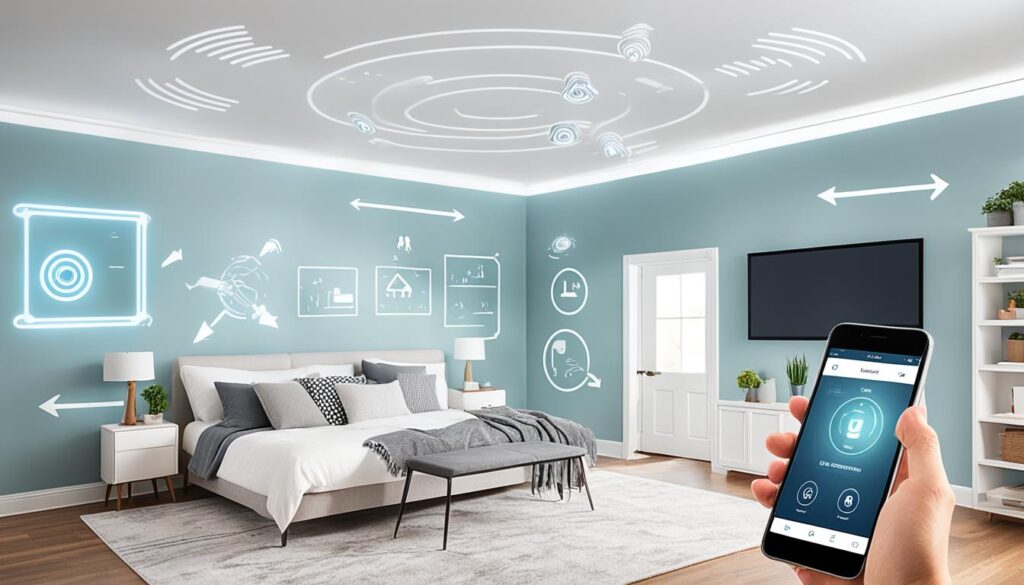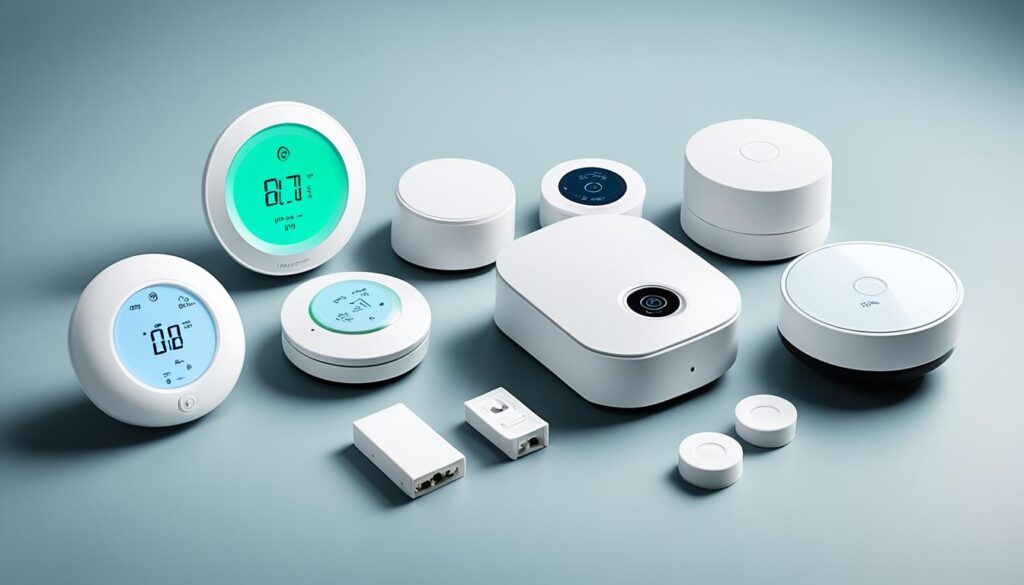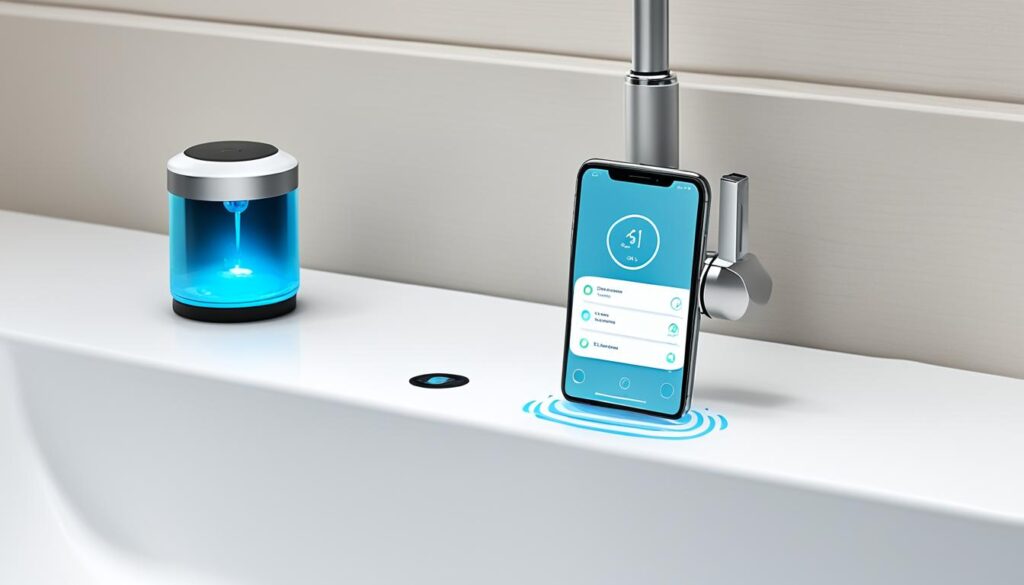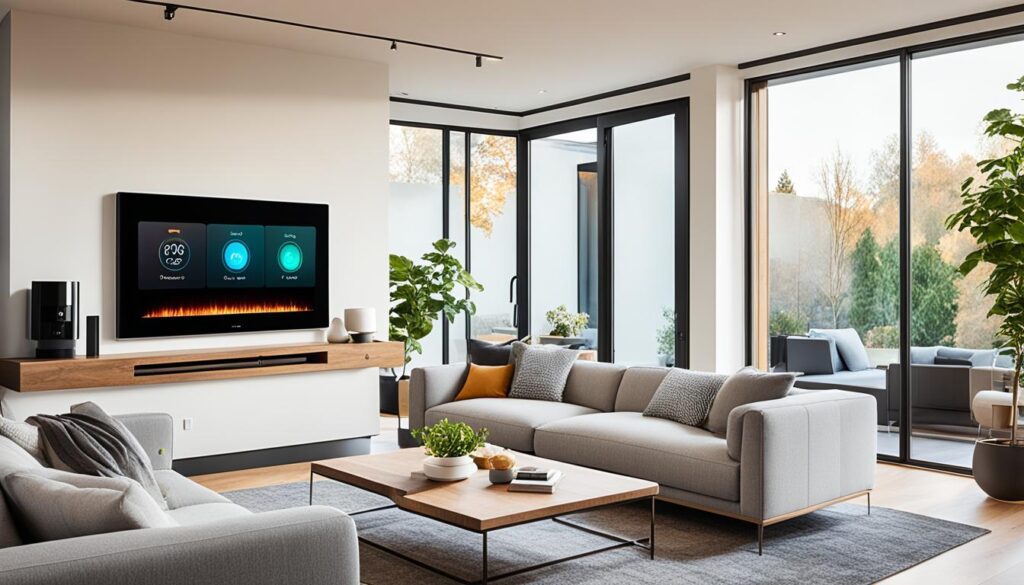Today’s world is more connected than ever. Smart home sensors are key parts of automation and security. These gadgets give you real-time info and let you watch over your home from afar. They can do things like detecting motion, checking temp and humidity, and monitoring doors and windows. They can even spot leaks and freeze conditions, plus keep an eye on the weather.1
When you pair these sensors with user-friendly apps, you can save energy, make your home safer, and add convenience. This guide will look at the must-have smart home sensors. These are essential for making your place smart, responsive, and truly connected.
Key Takeaways
- Smart home sensors give you live data and insights, letting you manage your home from a distance.
- They’re able to sense motion, track temperature and humidity, watch doors and windows, and even note water leaks and extreme cold.
- By connecting these sensors with apps, you can boost energy use, up security, and make life easier.
- There’s a wide array of these essential sensors, and our guide will show you the best ones for your smart home.
- Smart home sensors are pivotal in today’s automation and security systems, helping you build an intelligent and responsive living space.
Introduction to Smart Home Sensors
Imagine having devices that watch over your home and send you updates. That’s what smart home sensors do. They collect info on your house’s surroundings. Then, they let you check and adjust different parts of your home from afar. This makes an ecosystem where your home is smart, helping with tasks, safety, and making things easier.2
Why You Need Smart Home Sensors
Smart home sensors are like the heart of your smart home. They keep an eye on things like movement, how hot or cold it is, and how moist the air is. Then, you can use this info to make smarter choices about how your home works. You can also set things up to use less energy or be safer, all from a place far away. This makes living in your home better.2
Benefits of Smart Home Sensors
Having smart sensors in your home makes everything better in many ways:
- It makes your home safer by watching for movement and checking if doors or windows are opening.
- Your home uses energy better by adjusting heating, cooling, and lights as needed.
- You can keep an eye on your home’s conditions, find leaks, and get warned about things.
- You get more control over your home, all from far away, and many tasks can be automatic.
Using smart home sensors is like giving your home a big upgrade. It makes your home safer, more comfy, and it uses energy wiser.3
| Key Sensor Specifications | Value |
|---|---|
| Smart Sensors Market CAGR | 19% until 20263 |
| Wireless Protocols Supported | Wi-Fi, Thread, Bluetooth, Matter, Amazon Sidewalk, Z-Wave, Zigbee, Proprietary3 |
| Sensor Battery Life | Up to 10 years3 |
| Lowest-Power Wi-Fi 6 SoC | SiWx9173 |
| Sub-GHz SoC Battery Life | Up to 10 years3 |
Motion Sensors
Motion sensors are key in smart home setups. They provide info on when a room is used. They work via infrared to spot movement. This triggers set actions or alerts.4
How Motion Sensors Work
Motion sensors track movement by watching heat patterns. If something warm, like a person or pet, enters the area, it notices the change in heat. This cue can turn on lights, set off alarms, or send a message to your phone.
Top Motion Sensor Picks
For quality and value, the Aqara Motion Sensor P1 shines. It lasts up to five years on two coin batteries.4 At roughly $20, it’s a budget-smart choice to cover a whole house. Plus, it works with major smart home systems. This makes it very adaptable.4
Equally impressive is the Centralite Micro Motion Sensor, with its sleek design and long reach. It’s ideal for keeping an eye on busy areas in your home.
Advantages of Motion Sensors
Motion sensors have many perks for homeowners. The Aqara P1 is praised for its speed and ease of use. It’s quick to set up. Aqara even promises updates for at least two years after it’s no longer sold. This means it’s kept up-to-date without internet for peace of mind.4
They also help save energy. By turning off lights and adjusting temperature when a room is empty, they cut down on power use. This lowers bills.
Plus, in terms of security, motion sensors are a big help. They can warn of any strange movements in or around your home. Coupled with security systems, they boost your home’s safety. Helping to keep you and yours secure.4

Temperature and Humidity Sensors
Temperature and humidity sensors are key for making your home comfortable and saving energy. They check the air’s temperature and moisture, giving real-time info to adjust your heating, cooling, and air.5
The Centralite Temperature and Humidity Sensor is small, 70 x 70 x 21 mm, and uses Zigbee.5 It runs on two AA batteries you can change and lasts up to 5 years. It checks the air every 5 minutes. This device works between 0 and +50°C and with humidity of 5% to 85%, great for many indoor uses.5
The Aqara option tracks a wider range, from -40°C to 60°C for temperature and 0% to 100% for humidity.6 Its temperature readings are usually accurate within ±0.3°C / ±0.5°F for an average house temperature of 0°C to 60°C, with the best accuracy being ±0.5°C / ±0.9°F.6 For the whole temperature range, it’s typically accurate within ±0.7°C / ±1.3°F, at most ±1.2°C / ±2.2°F.6 Humidity readings at 25°C / 77°F are usually within ±3% for humidity levels between 20% to 80%, and within ±4.5% for anywhere from 0% to 100%.6
Both the Centralite and Aqara sensors offer precise and reliable environment monitoring for smarter homes. This helps homeowners adjust their air and heat systems for better energy use and comfort.56
| Feature | Centralite Temperature and Humidity Sensor | Aqara Temperature and Humidity Sensor |
|---|---|---|
| Dimensions | 70 x 70 x 21 mm5 | N/A |
| Communication Protocol | Zigbee5 | N/A |
| Power Source | 2 x AA, exchangeable5 | N/A |
| Battery Life | 5 years, reporting every 5 minutes5 | Over 1 year, less in extreme cold6 |
| Temperature Range | 0 to +50°C5 | -40°C to 60°C (-40°F to 140°F)6 |
| Humidity Range | 5% – 85%5 | 0% to 100%6 |
| Temperature Accuracy | N/A | Typical ±0.3°C / ±0.5°F (0°C – 60°C/32°F – 140°F), Max ±0.5°C / ±0.9°F6 Typical ±0.7°C / ±1.3°F, Max ±1.2°C / ±2.2°F (Full Range)6 |
| Humidity Accuracy | N/A | Typical ±3% (20% – 80% RH), Max ±4.5% Typical ±4.5%, Max ±7.5% (0% – 100% RH)6 |
| Certifications | CE, RoHS, REACH5 | N/A |
Putting these sensors in your home helps you keep track of the indoor weather. Then, you can better manage your air, heating, and cooling systems. This leads to less energy waste and more comfort at home.56
Smart Home Sensors
What Are Smart Home Sensors?
Smart home sensors are high-tech tools that check and send details about a home’s state.1 They play a key part in making your home smart, letting you watch and manage your space from afar.1
Types of Smart Home Sensors
The market for smart home sensors is vast. You can find sensors for temperature, light, movement, and more.1 These devices give you info that can make your home safer, more efficient, and convenient.1
Some important smart sensors are:
- Motion sensors: They notice when there’s activity and can start or stop things automatically.
- Temperature and humidity sensors: They keep an eye on the air and work with your AC to keep things just right.
- Door and window sensors: They tell you if doors or windows are open, which is good for security and knowing how your home is being used.
- Leak and freeze sensors: They alert you to leaks or cold spots, helping you avoid big repair bills.
- Smoke and carbon monoxide detectors: They check the air for harmful stuff, keeping your family safe.
- Video doorbells: They let you see and talk to visitors at your door, even when you’re not home.
- Weather sensors: They bring in info from outside, helping you adjust things like sprinklers automatically.
Putting these smart sensors in your home can make it better in many ways. It’s how you turn your house into a smart home.1

Door and Window Sensors
Doors and windows are key entry points to your home. They help keep it safe and energy efficient. Door and window sensors are important for your smart home. They check if doors and windows are open or closed. This gives you data and makes your home more secure.
Benefits of Door and Window Sensors
Using door and window sensors has many pluses for your smart home. They alert you when something is opened. This can scare off burglars and keep your home safer.7 Also, these sensors help you save energy. They show where you can seal better to use less energy.7
Top Door and Window Sensor Recommendations
For the best door and window sensors, here are some top picks. The YoLink Smart Home Starter Kit costs $75.99 and reaches up to a quarter of a mile.7 The Aqara Sensor is budget-friendly at $24.99 and needs a hub.7 HomeKit fans might like the Eve Sensor for $39.95, which works smoothly and comes with spacers.7 The GE Personal Security Sensor is loud at 120dB and costs $19.50. It’s great for people who care a lot about security.7
Adding top-notch sensors to your smart home boosts security and saves energy. You can find the right sensor for a fair price or for a specific smart home system. There’s something for everyone in the market.
Leak and Freeze Sensors
In today’s smart home scene, leak and freeze sensors are key. They help keep your home safe from water damage and more. These smart sensors are vital for homeowners who want to protect their investment.8
Importance of Leak and Freeze Sensors
Water leaks and frozen pipes can cause big problems in your home. They lead to costly repairs and lots of damage. Sensors like the Roost Smart Water Leak & Freeze Detector warn you at the first hint of trouble.8 They find leaks under sinks, dishwashers, toilets, and water heaters. Plus, they alert you if pipes are about to freeze. This quick warning lets you act fast and avoid spending a lot on fixing the damage.
How Leak and Freeze Sensors Work
These sensors mix water detection with watching the temperature. When they sense a problem, like a leak or a temperature drop, they tell your phone. This quick notice helps you react fast.8 For instance, the Roost Smart Detector’s battery lasts up to 3 years. It stays on even if the power goes out.8 They’re easy to install and fit well with your smart home setup. They give you peace of mind and act against water damage quickly.8
Getting these sensors can protect your home and save you money. They don’t just alert you; they can stop water flow to prevent further damage.8 With their support for different smart home systems, these sensors are perfect for anyone who values safety. They aim to stop big water disasters from happening.

Smoke and Carbon Monoxide Detectors
Smart smoke and CO detectors are key devices for a safe smart home. They warn homeowners early about fire and gas risks. These sensors find smoke and toxic gas and work with smart home systems. This allows for remote checks, personalized alerts, and emergency help.9
Features of Smart Smoke and CO Detectors
Today’s smart detectors do more than old alarms. The First Alert SA320CN Alarm has two sensors to spot different fires. It cuts down false alarms from cooking, preventing turning it off. This keeps users safe.9
These smart devices link with home systems. They send updates, check air, and start help from anywhere. The TREATLIFE Alarm lasts 10 years and connects with many others for full home safety.10
Installing them is simple since they use batteries. You don’t need an electrician. They tell real fires from fake ones. This quick, accurate warning saves lives.9
Smart detectors are vital for safe modern homes. They give peace of mind and help react fast to dangers.910
Video Doorbells
Video doorbells are a game-changer for home security. They let you see who’s at your door from anywhere. These devices are more than just doorbells. They give you the power to keep an eye on your home and spot threats easily.
Advantages of Video Doorbells
Installing a video doorbell has many benefits. It’s great for making your home safer, spotting visitors from afar, and making life easier. With a video doorbell, you can talk to visitors no matter where you are. This helps keep intruders away.11 Plus, these doorbells are smart. They can tell the difference between people, animals, or a package arriving. This keeps your alerts important and not flooded with every little movement.11
One big plus is viewing live videos and past clips right from your phone.11 You can watch your front door, say hi to guests, or deal with packages, even when you’re not home. Remember, you don’t always need a special app to use these doorbells through your browser.11 This makes them even more handy.
Top Video Doorbell Recommendations
When choosing a video doorbell, the Google Nest Doorbell (Wired) shines. It comes with free cloud storage and excellent camera quality.11 It’s also smart enough to tell you what’s happening. It knows if it’s a person, animal, car, or just moving shadows.11
The Nest Doorbell lets you set up to four motion zones. This means you can focus on the areas that matter most.11 With the Nest Aware service, you get really cool features. It can even remember faces of regular visitors.11 Plans start at $8 a month for a month of video storage. Or, you can pick 24/7 recording for $15 a month.11
There are also other great video doorbells, like the Arlo Essential and the Ring Pro 2. They all offer quality video, work well with smart homes, and provide strong security. The best one for you depends on what you need, how much you want to spend, and the devices you already have at home.

Weather Sensors
Weather sensors are a key part of a smart home. They give us info on the weather outside. This helps us adjust our home to be more comfortable, save energy, and be convenient.4
Benefits of Weather Sensors
These sensors have many pluses for smart homes. They watch temperature, humidity, wind, and rain. This data is then used to automate things, making your home more comfortable. It also helps in emergencies, like bad weather alerts.4
How Weather Sensors Integrate with Smart Home
Integrating weather sensors takes your smart home to the next level. They can connect with Amazon Alexa, Google Home, or Apple HomeKit. This connection means your home can react to the weather automatically. It makes your home more comfortable and saves energy.4
Weather sensors also help you use energy smarter. They show how weather affects heating, cooling, and water use. This info helps you cut down on energy use and costs. It’s good for the planet, too.4

Adding weather sensors to your home is a smart move. They use real-time data to make your home life better. Your home becomes intelligent and adapts to changes in the weather.4
Choosing the Right Smart Home Sensors
When looking at smart home sensors, it’s crucial to think about several important things. You need to consider how well these sensors will work with your home’s smart systems. This includes making sure they fit with your favorite smart home platforms and automation. By understanding what your home needs, you can pick the best sensors for more convenience, safety, and saving energy.
Factors to Consider When Selecting Sensors
Choosing the right sensors means looking at features and compatibility.4 For instance, the Aqara Motion Sensor P1 is a great choice for motion detection. It has a long battery life, responds quickly, and is easy to set up.4 The P1 can last up to five years on just two coin batteries. It costs around $20, which is great for different areas in a home.4 Tests checked if it could communicate well with other sensors from far away too.4
It’s also vital to choose sensors based on what they can detect. Think about what your home needs for safety and saving energy. This could be motion sensing, checking the temperature, finding water leaks, or alerting smoke or CO.12 Making the right choice helps your home stay safe and efficient.12
Compatibility with Smart Home Platforms
It’s very important to make sure your sensors work well with other smart devices in your home.4 For example, the Aqara Motion Sensor P1 syncs easily with Amazon Alexa, Google Home, Apple Home, and IFTTT. This allows for full automation in your smart home.4
Choose sensors that can connect with your preferred smart home system. Whether you use Apple HomeKit, Google Home, Amazon Alexa, or Samsung SmartThings, compatibility is key. This helps you manage all sensors and devices together, creating a smart and unified system.12

By picking the right smart sensors and making sure they work with your other devices, you can greatly improve your smart home. The right sensors can make your home safer, more efficient, and easier to live in. This changes how you experience and take care of your home.
Setting Up and Using Smart Home Sensors
Setting up smart home sensors is key to making your home smarter. This allows you to enjoy the benefits of smart technology. You can control things easily and create a smart home that works well together.
Installation Tips for Smart Home Sensors
Installing smart home sensors is usually easy. They are made to be used by anyone. You often don’t need many tools or deep tech skills. Fast Pair for Matter devices makes the setup even simpler. This helps make your home smart in no time.13 Also, the Nest Thermostat works in a lot of homes without needing a C wire. This makes it easier to install.13
Where you put the sensors matters a lot too. You should think about where they are in your home. They should be near the places you want to keep an eye on. They need to be close to power and not blocked by other things. This way, they work better, whether they’re checking for movement, temperatures, or watching doors.
Integrating Sensors with Smart Home Apps
After setting up, link the sensors with your smart home app. You’ll connect them to your Wi-Fi and your favorite app or voice assistant.13 Devices like the Nest Audio speakers with Google Assistant make using your smart home fun. They let you control things by just talking to them.13
In the app, you can make the sensors work the way you want. You can set alerts, schedules, and routines. This makes your day smoother.13 For example, motion sensors can turn lights off when no one’s in the room. This saves power and makes life simpler.13 Using the app with your sensors makes your home more responsive and energy-efficient.
FAQ
What are smart home sensors?
Smart home sensors gather and send data about your home’s state. They are key for a smart home setup, letting you keep an eye on your home from anywhere.
What are the benefits of using smart home sensors?
These sensors help make your home smarter and safer. They improve how your home runs, boost security, and make life easier. They can tell when it’s cold, if there’s movement, or if a window is open. They even track the weather.
What are the different types of smart home sensors?
The common types include those for motion, heat, and moisture. There are also sensors for doors and windows, leaks, smoke, and more. Each type helps in a different way.
How do motion sensors work in a smart home?
Motion sensors use infrared to spot moving objects. They can trigger lights or alarms, making your home more efficient and secure.
What are the benefits of temperature and humidity sensors in a smart home?
These sensors keep track of a room’s temperature and moisture. They help make your home comfortable and save energy.
How do door and window sensors enhance smart home security?
Door and window sensors check if these entry points are secure. They alert you to openings and can set off a chain of protective actions.
What is the importance of leak and freeze sensors in a smart home?
These sensors guard against water damage and extreme cold. They warn you early, stopping a problem before it gets serious.
How do smart smoke and carbon monoxide detectors improve home safety?
These detectors warn you about fires and dangerous gases. They can call for help and work with other smart home devices to keep you safe.
What are the benefits of a video doorbell in a smart home?
A video doorbell shows you who’s at the door. It records visitors and lets you talk to them from anywhere. It makes your home safer and more convenient.
How do weather sensors integrate with a smart home system?
Weather sensors give data about outside conditions. This helps your home adjust for weather and plan for emergencies.
What factors should I consider when selecting smart home sensors?
Think about how well they work with your home setup. Look for easy setup, accurate data, and if they meet your home’s needs. Pick ones that fit your system perfectly to get the best out of them.
How do I set up and integrate smart home sensors into my living space?
Setting up sensors right makes your home smart and effective. Place them where instructions say, connect to Wi-Fi, and link with your devices. Doing this makes them work best and helps your home run smoothly.
Source Links
- https://www.enercare.ca/blog/smarter-home/9-sensors-every-smart-home-needs
- https://www.techtarget.com/iotagenda/definition/smart-home-or-building
- https://www.silabs.com/applications/smart-home/sensors
- https://www.nytimes.com/wirecutter/reviews/best-smart-home-sensors-for-alexa/
- https://frient.com/products/smart-humidity-sensor/
- https://www.sensorpush.com/products/p/ht1
- https://www.safewise.com/resources/door-window-sensors/
- https://getroost.com/sensors/
- https://www.firstalertstore.com/store/products/smoke-alarm-with-smart-sensing-technology-sa320cn.htm
- https://www.treatlife.tech/products/treatlife-smart-wifi-smoke-carbon-monoxide-detector-battery-backup-app-notification-wireless-interconnect
- https://www.nytimes.com/wirecutter/reviews/best-smart-doorbell-camera/
- https://www.vesternet.com/pages/choosing-sensors
- https://store.google.com/intl/en/ideas/articles/curious-about-smart-home-devices-start-here/
